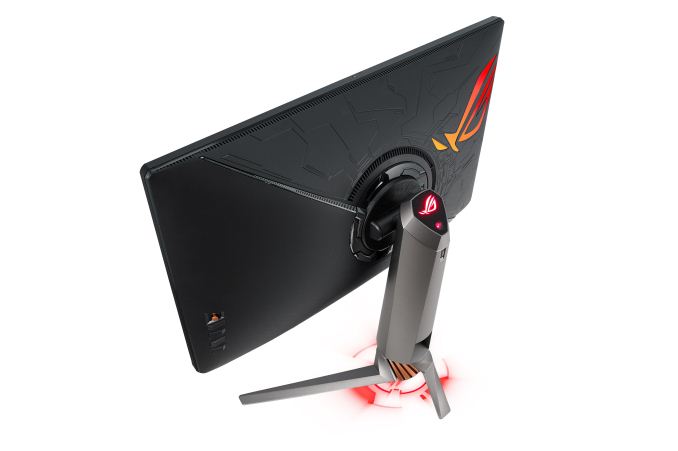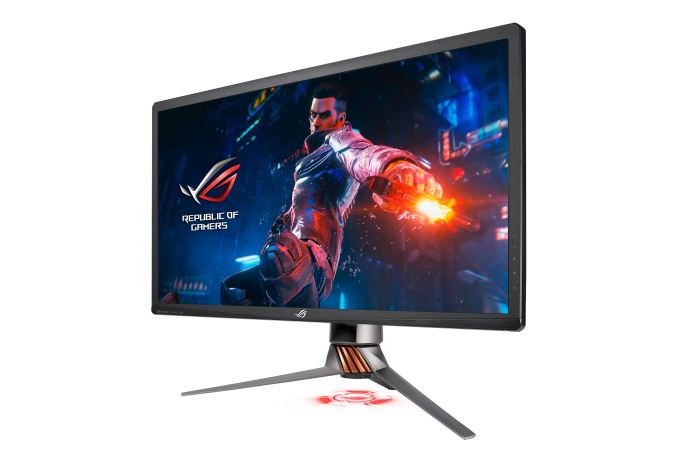The Asus ROG Swift PG27UQ G-SYNC HDR Monitor Review: Gaming With All The Bells and Whistles
by Nate Oh on October 2, 2018 10:00 AM EST- Posted in
- Monitors
- Displays
- Asus
- NVIDIA
- G-Sync
- PG27UQ
- ROG Swift PG27UQ
- G-Sync HDR
The (Asus) G-Sync HDR Experience: Premium Panel for Premium Price
In the end, gamers are given the ultimate guidance with the price point: $2000. The cost doesn't pull any punches, and while it may not be explicitly communicated to consumers, the price is all about the panel functionality, while everything else takes the backseat. Though we can only say this directly about the Asus PG27UQ, this is presumably the case for Acer's Predator X27, which shares the connectivity, large physical design, and active cooling setup.
Some of this is out of Asus's hands, and with the G-Sync HDR module's capabilities and limitations, something that they can only package up and support the best they can. Manufacturers on the display design side would be limited in expanding the basic range of use of G-Sync HDR. Some aspects are even out of NVIDIA's hands when it comes to HDR support in the OS, which goes back to Windows' historically poor management of anything non-SDR and non-sRGB; if the monitors were ready before the Windows 10 April 2018 Update, ease-of-use would've been a big issue.
As one of two current G-Sync HDR implementations, the Asus PG27UQ is also just one of three VESA DisplayHDR 1000 certified products, alongside the Acer counterpart and a Phillips 4K TV, and one of three UHDA Premium certified monitors, alongside two proviz monitors. So by certifications, it would be one of the best HDR PC monitors on the consumer market anyway, G-Sync or otherwise. It seems more likely than not that the 35-inch and 65-inch models are not imminently ready, although resolving firmware issues with FALD backlighting should be a shared investment between them. But for now, G-Sync HDR can only truly stretch its legs in a niche case: single-monitor non-silent PC gaming with HDR titles on NVIDIA G-Sync HDR supporting hardware powerful enough to target 4Kp144 target. The last bit is already niche on its own: the GeForce GTX 1080 Ti was the first card to really hit 60fps on no-compromises 4K, and both AMD and NVIDIA have stepped back from multi-GPU and multi-card solutions.
As an aside, we know now 144fps is perhaps even further out given that NVIDIA's next generation offering of the GeForce RTX 2080 Ti is more-or-less in the Titan V gaming performance bracket, which is to say it's only about 37% faster than the GTX 1080 Ti. The majority of this review was done prior to the RTX 2080 Ti and RTX 2080 launch, but doesn't fundamentally alter the core premise of 4Kp144 being out-of-reach.
And when you're paying more dollars than most people have horizontal pixels on their screen, especially when that price is especially baked in to that use case, that niche becomes extremely relevant. There's no price tiering right now in terms of non-4K G-Sync HDR or non-HDR 4Kp144 G-Sync, so pursuing either combination still leaves you at the $2000 price point. So let's find out if the prospect of playing PC games with the cutting-edge of 2018 visuals measure up.












91 Comments
View All Comments
Ryan Smith - Wednesday, October 3, 2018 - link
Aye. The FALD array puts out plenty of heat, but it's distributed, so it can be dissipated over a large area. The FPGA for controlling G-Sync HDR is generates much less heat, but it's concentrated. So passive cooling would seem to be non-viable here.a5cent - Wednesday, October 3, 2018 - link
Yeah, nVidia's DP1.4 VRR solution is baffelingly poor/non-competitive, not just due to the requirement for active cooling.nVidia's DP1.4 g-sync module is speculated to contribute a lot to the monitor's price (FPGA alone is estimated to be ~ $500). If true, I just don't see how g-sync isn't on a path towards extinction. That simply isn't a price premium over FreeSync that the consumer market will accept.
If g-sync isn't at least somewhat widespread and (via customer lock in) helping nVidia sell more g-sync enabled GPUs, then g-sync also isn't serving any role for nVidia. They might as well drop it and go with VESA's VRR standard.
So, although I'm actually thinking of shelling out $2000 for a monitor, I don't want to invest in technology it seems has priced itself out of the market and is bound to become irrelevant.
Maybe you could shed some light on where nVidia is going with their latest g-sync solution? At least for now it doesn't seem viable.
Impulses - Wednesday, October 3, 2018 - link
How would anyone outside of NV know where they're going with this tho? I imagine it does help sell more hardware to one extent or another (be it GPUs, FPGAs to display makers, or a combination of profits thru the side deals) AND they'll stay the course as long as AMD isn't competitive at the high end...Just the sad reality. I just bought a G-Sync display but it wasn't one of these or even $1K, and it's still a nice display regardless of whether it has G-Sync or not. I don't intend to pay this kinda premium without a clear path forward either but I guess plenty of people are or both Acer and Asus wouldn't be selling this and plenty of other G-Sync displays with a premium over the Freesync ones.
a5cent - Wednesday, October 3, 2018 - link
"How would anyone outside of NV know where they're going with this tho?"Anandtech could talk with their contacts at nVidia, discuss the situation with monitor OEMs, or take any one of a dozen other approaches. Anandtech does a lot of good market research and analysis. There is no reason they can't do that here too. If Anandtech confronted nVidia with the concern of DP1.4 g-sync being priced into irrelevancy, they would surely get some response.
"I don't intend to pay this kinda premium without a clear path forward either but I guess plenty of people are or both Acer and Asus wouldn't be selling this and plenty of other G-Sync displays with a premium over the Freesync ones."
You're mistakenly assuming the DP1.2 g-sync is in any way comparable to DP1.4 g-sync. It's not.
First, nobody sells plenty of g-sync monitors. The $200 price premium over FreeSync has made g-sync monitors (comparatively) low volume niche products. For DP1.4 that premium goes up to over $500. There is no way that will fly in a market where the entire product typically sells for less than $500. This is made worse by the fact that ONLY DP1.4 supports HDR. That means even a measly DisplayHDR 400 monitor, which will soon retail for around $400, will cost at least $900 if you want it with g-sync.
Almost nobody, for whom price is even a little bit of an issue, will pay that.
While DP1.2 g-sync monitors were niche products, DP1.4 g-sync monitors will be irrelevant products (in terms of market penetration). Acer's and Asus' $2000 monitors aren't and will not sell in significant numbers. Nothing using nVidia's DP1.4 g-sync module will.
To be clear, this isn't a rant about price. It's a rant about strategy. The whole point of g-sync is customer lock-in. Nobody, not even nVidia, earns anything selling g-sync hardware. For nVidia, the potential of g-sync is only realized when a person with a g-sync monitor upgrades to a new nVidia card who would otherwise have bought an AMD card. If DP1.4 g-sync isn't adopted in at least somewhat meaningful numbers, g-sync loses its purpose. That is when I'd expect nVidia to either trash g-sync and start supporting FreeSync, OR build a better g-sync module without the insanely expensive FPGA.
Neither of those two scenarios motivates me to buy a $2000 g-sync monitor today. That's the problem.
a5cent - Wednesday, October 3, 2018 - link
To clarify the above...If I'm spending $2000 on a g-sync monitor today, I'd like some reassurance that g-sync will still be relevant and supported three years from now.
For the reasons mentioned, from where I stand, g-sync looks like "dead technology walking". With DP1.4 it's priced itself out of the market. I'm sure many would appreciate some background on where nVidia is going with this...
lilkwarrior - Monday, October 8, 2018 - link
Nvidia's solution is objectively better besides not being open. Similarly NVLINK is better than any other multi-GPU hardware wise.With HDMI 2.1, Nvidia will likely support it unless it's simply underwhelming.
Once standards catch up, Nvidia hasn't been afraid to deprecate their own previous effort somewhat besides continuing to support it for wide-spread support / loyalty or a balanced approach (i.e. NVLINK for Geforce cards but delegate memory pooling to DX12 & Vulkan)
Impulses - Tuesday, October 2, 2018 - link
If NVidia started supporting standard adaptive sync at the same time that would be great... Pipe dream I know. Things like G-Sync vs Freesync, fans inside displays, and dubious HDR support don't inspire much confidence in these new displays. I'd gladly drop the two grand if I *knew* this was the way forward and would easily last me 5+ years, but I dunno if that would really pan out.DanNeely - Tuesday, October 2, 2018 - link
Thank you for including the explanation on why DSC hasn't shown up in any products to date.Heavenly71 - Tuesday, October 2, 2018 - link
I'm pretty disappointed that a gaming monitor with this price still has only 8 bits of native color resolution (plus FRC, I know).Compare this to the ASUS PA32UC which – while not mainly targetted at gamers – has 10 bits, no fan noise, is 5 inches bigger (32" total) and many more inputs (including USB-C DP). For about the same price.
milkod2001 - Tuesday, October 2, 2018 - link
Wonder if they make native 10bit monitors. Would you be able to output 10bit colours from gaming GPU or only professional GPU?